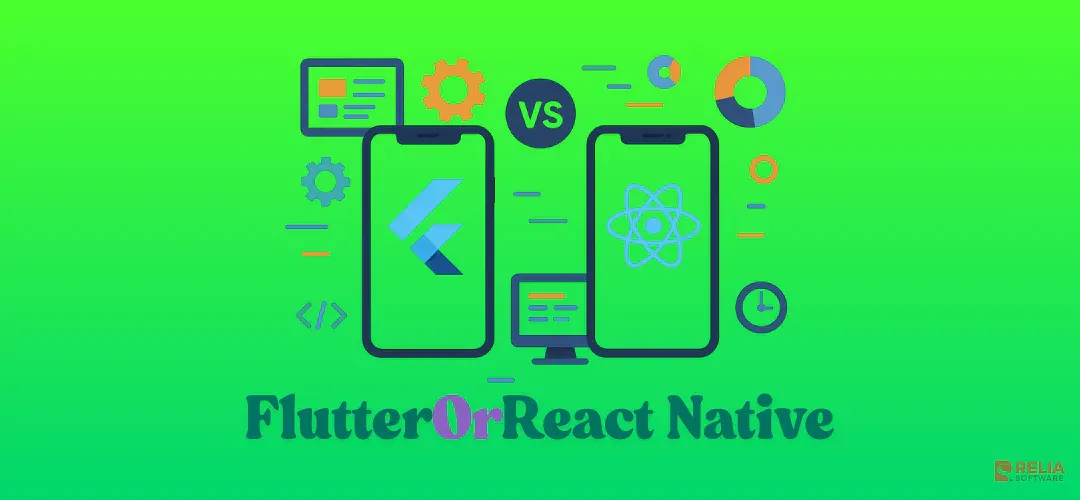To decide between technological offerings for business development can be a task inundated with several dilemmas. When posed with a challenge whether to implement Flutter or React native technology, it becomes crucial to take into consideration the pros and cons of both choices. The contenders being two app frameworks: Flutter and React Native. Which platform will be chosen? Let's answer yourself via this article!
>> Relia Software provides Flutter and React Native development services <<
Flutter App Development Company | USA & Vietnam
React Native App Development Company | USA & Vietnam
Short Brief About Flutter and React Native
|
Flutter |
React Native | |
|
Definition |
An open-source UI toolkit for cross-platform development from a single codebase. |
A cross-platform development framework using React. |
|
Release Date |
5/2017, Google I/O |
03/2015, F8 Conference |
|
Created by |
|
Meta |
|
Language |
Dart |
JavaScript |
|
Platforms |
|
|
|
Popularity |
157.000 stars on GitHub (09/2023) |
112.000 stars on GitHub (09/2023) |
|
Free and Open-source |
✔ |
✔ |
|
Hot Reload Feature |
✔ |
✔ |
|
Time to market |
Fast because of its pre-built UI component library. It's perfect for MVPS. |
Fast, although platform-specific optimizations could make it slower than Flutter. |
Detailed Comparison Between Flutter and React Native
Performance
Flutter
>> Read more: What is Flutter? Building Beautiful Cross-Platform Apps
Makes use of its Ahead-of-Time compiler, which produces code that is optimized for both iOS and Android after a project has been generated. This, like React Native, guarantees native-level performance without embedding the complete codebase in the application binary. Flutter also avoids the need for a bridge between itself and native modules, unlike React Native.
React Native
Features a superior JavaScript virtual machine that outperforms V8's JIT compiler. It's a framework that's already been precompiled, thus it can be used to deploy and compile any codebase into a native executable. React Native typically performs at the same level as native iOS apps do, without requiring any modifications to the iOS build settings.
>> Read more:
UI Development
Flutter
Doesn’t depend on native system components. Instead, Flutter offers its own collection of widgets for UI rendering, making it possible to use existing iOS or Android code in Flutter apps. With a shared codebase, your app will function and appear the same across all versions of iOS and Android, from the most recent to the oldest.
Material Design widgets (Google's design language) and Cupertino widgets (Apple's iOS design) are two categories of widgets that are included in Flutter. This means that Flutter apps will imitate each platform's native components and seem and function naturally.
React Native
Supports the integration of existing iOS and Android code as JavaScript modules by providing a bridge. Additionally, it offers APIs that make manual bridging between native UI components and the pertinent JavaScript rendering code easier.
As a result, application components have the same appearance as native components. For instance, a button on an iOS or Android device looks just like a native iOS button.
Consider using third-party libraries if your apps need to look nearly the same on all devices, including those running older operating systems (as Flutter does). They enable the use of Material Design components as opposed to native ones.
Sharing Code
Flutter
-
Single Codebase: Flutter, a programming framework based on Dart programming language, enables programmers to create a single codebase that works on both iOS and Android. This may result in approximately 100% platform-wide code reuse.
-
Custom Widgets: Flutter employs a graphics engine to render its own widgets rather than relying on native components for rendering. This guarantees uniform appearance and behavior across all devices.
React Native
-
High Code Reuse: JavaScript, which is supported on iOS and Android, may be used by developers to write the majority of the logic for React Native applications. 80–90% of the code is often transferable between platforms.
-
Native Components (by default): As we already mentioned, React Native works by utilizing platform components. As a result, a widget for an app will feel and appear native. As a result, the widget for an app will feel and appear native. However, because Flutter starts from scratch, there may be inconsistencies with native ones.
-
Native Modules: Although most of the application logic is written in JavaScript, React Native enables the inclusion of native code (Swift, Java, etc.) when necessary to enhance performance or accomplish platform-specific functionality. There may be less shared code as a result occasionally.
-
Bridging: Bridges are used by React Native to connect the JavaScript code and native modules, enabling slick interaction but occasionally causing performance problems.
Documentation
Flutter
-
Thorough and well-organized: The documentation for Flutter is comprehensive and covers a wide range of subjects.
-
A library of interactive widgets: Aids in viewing and comprehending UI components.
-
Tutorials and codelabs: Flutter provides lessons and codelabs that let users gain practical coding skills.
-
Specific instructions or various audiences. The manual offers specialized instructions to developers with a variety of backgrounds, including Android, iOS, Web, etc.
React Native
-
Community-driven: The documentation for React Native has benefited tremendously from community contributions.
-
Snippets and examples: Developers may easily understand and use features since documentation includes code snippets and examples.
-
Separation between core and community modules: Both core and community modules are part of the React Native ecosystem. They are distinct from one another in the paperwork.
-
External resources: The framework has a multitude of tutorials, articles, and third-party material available given its age and popularity.
In conclusion, if you appreciate organized, comprehensive, and interactive official materials, you might incline toward Flutter's documentation. React Native's documentation may be more appealing if you like a robust ecosystem with a balance of official and community-driven resources.
Debugging
Flutter
Offers an app debugger for iOS and Android. Additionally, it gives programmers access to tools for monitoring memory usage and making quick adjustments, as well as information on the state of the rendering engine.
React Native
Has an integrated debugger for iOS and Android apps that enables developers to see the current state of the JavaScript virtual machine and access tools for monitoring memory utilization and making modifications in real time.
App Size
Flutter
Developers can send solely their application's codebase without bundling using a prebuilt compiler. Flutter can be executed inside an existing JavaScript virtual machine (VM) to reduce the size of the application.
React Native
Apps usually include a 300-kb gzipped JavaScript runtime. This size can be lowered by bypassing filling, which prevents virtual DOM diffing, and activating useDeveloperMode to shrink in-memory images and lower their quality.
Data Security
Flutter
However, Flutter shines in security. Flutter apps' machine code cannot be reverse-engineered, making decompilation virtually impossible. This makes Flutter better for high-security tasks.
Flutter's safe storage, encryption, and sandboxing add another degree of security. For projects with strict security requirements, Flutter's security features are better.
React Native
React Native lacks data security. The release build's JavaScript code is vulnerable, threatening the app. Therefore, React Native is inappropriate for financial or banking apps with strong security needs.
Security aspects in React Native are mostly provided by third-party libraries. This can cause inconsistencies and compatibility issues across React Native versions and frameworks.
>> You may consider: Data Security in Healthcare Software: Why Is It Important?
Testing and Development Speed
Flutter
Flutter offers Android Studio, VS Code, and many plugins for development. Hot Reload helps developers view code changes rapidly. Flutter apps use widgets to simplify and speed up development process.
React Native
Fast Refresh lets developers add code to a running project in React Native. However, React Native updates can damage libraries. Not all automatic version update mechanisms operate, requiring manual updates for specific components.
Learning Ease
Flutter
Flutter is based on Dart, a rare and difficult language. However, Java developers may learn faster. Developer guides are available for Flutter, which is rising in popularity. Flutter developers are also creating self-study and training materials.
React Native
However, React Native is based on JavaScript, a popular programming language among front-end developers. As one of the simplest languages, it's ideal for beginner developers.
Competitive Advantage
Flutter
-
Rich widgets allow for a beautiful design.
-
Community and popularity are expanding rapidly.
-
It's simple to get started with Flutter development because of the excellent documentation and consistent assistance from the Flutter team.
-
One codebase for both mobile and online platforms is now available thanks to Flutter for web.
-
Time-to-market efficiency is tough to beat.
React Native
-
Many top market participants use React Native.
-
Large, mature community.
-
Learnable technology.
-
Many guides and libraries make development easier.
-
Reusing code for web and desktop apps is easy.
Flutter vs React Native: Which is A Better Choice?
When You Should and Should Not Use Flutter?
Flutter work well when:
-
Develop native Android and iOS on a reduced budget without two development teams
-
Short timeline for product release
-
Get pixel-perfect designs and components for a fantastic UI.
-
User experience must be cross-platform (desktop, mobile, car infotainment).
Flutter might not be the best choice if your app:
-
Needs 3D Touch support (Flutter is planning it)
-
Has platform-specific design
-
Needs extensive OS interaction or niche native libraries
-
Prefers a minimalist UI yet uses phone hardware (music player, camera-only app)
-
Designed as a simple, quick app
>> Read more: Is Flutter Good For Web Development? Benefits & Drawbacks
When You Should and Should Not Use React Native?
Flutter work well when:
-
You can reuse desktop apps or website components for mobile app (same tech stack).
-
Your JavaScript team can use plug-ins, modules, and widgets from the massive npm repository since they know your assets.
-
Finding a team of React Native developers (Flutter developers are tougher to locate) is urgent.
React Native might not be the best choice if your app:
-
Needs specific background tasks, such as specific calculations.
-
Custom Bluetooth communication (React Native challenge).
-
For Android only.
Conclusion
Flutter and React are superior at their own things. The framework you use should depend on your needs and audience. If you want professional developers to help you build a project from scratch, Relia Software is the place to approach. A strong Flutter and React Native team at Relia creates consistent and user-friendly apps.
>>> Follow and Contact Relia Software for more information!
Our email: sales@reliasoftware.com
- React Native
- coding

